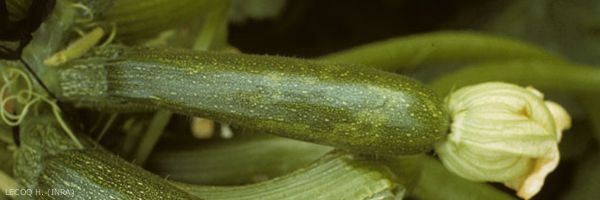
Watermelon mosaic virus (WMV)
Watermelon mosaic virus
(Potyviridae, Potyvirus)
WMV is a potyvirus transmitted by aphids in the non-persistent mode. It is reported on Cucurbitaceae in the main production areas of the world in temperate and Mediterranean climates , mainly in open fields .
WMV is very common in Europe , America and North Africa, the Middle East and Asia. It was first described in France in 1974. An epidemiological survey carried out in mainland France in the main production areas from 2004 to 2008 revealed that WMV was the most common virus in Cucurbitaceae : it was present in more than 82% of the 2660 samples analyzed. There is, however, a certain regional diversity: it is very common in the South-East of France, a little less in the South-West, and it is still quite rare in the Center-West. Its frequency also varies according to the species considered: It is very present in zucchini (94% of samples analyzed), squash (85%), melon (78%) and rarer in cucumber, a species mainly cultivated under shelters (14% of samples analyzed).
Certain strains of WMV, and particularly the EM strains recently appeared in France , can cause severe mosaic symptoms and deformation on the foliage and discolorations or even deformations on the fruits. Early attacks sometimes lead to significant yield losses.
Surprisingly, WMV is not reported in tropical production areas and quite rarely in subtropics, although aphid vectors are abundant there. Thus, we have so far never isolated the WMV in the West Indies, in southern Florida or in West or East Africa. This observation is a little paradoxical since this virus infects a tropical species, vanilla, particularly in the Pacific Islands where it causes serious disease of this Orchid.
WMV was first reported in Florida in 1954. However, for almost 25 years some confusion reigned about it because very quickly two strains called WMV1 and WMV2 were distinguished according to their host ranges. The WMV1 infects cucurbits, the WMV2 has a range of much wider hosts including legumes and many weed species. Serological studies established in the early 1980s that WMV1 was in fact a strain of a different virus, Papaya ringspot virus (PRSV), with WMV2 then becoming the "real" WMV.
The characterization of its genome revealed an original property: it would be the result of a recombination * between two viruses infecting legumes, Soybean mosaic virus (soybean ) and mosaic virus Bean common mosaic virus common mosaic virus) ( beans) which do not infect Cucurbits. Perhaps it is this recombination that allowed WMV to extend its host range to Cucurbitaceae.
The study of numerous isolates of WMV of various geographical origins showed the existence of three molecular groups according to the sequence of their capsid protein **: groups 1, 2 and 3. Until the end of the years 90, we found in France mainly strains of group 1, which are also called the "classic" strains (CL), and some strains of group 2 in the Nice region. These two types of strains have been reported in other countries of the Mediterranean Basin (Spain, Tunisia). In the early 2000s, a new type of strain belonging to group 3 [also called emerging strains (EM)] appeared in the South-East of France. Since then, these strains, often associated with more severe symptoms, have become well established and tend to replace the CL strains present until then. EM strains closely resemble strains described in the Far East (China, Japan), but today we do not know either their real geographical origin or their route of introduction into France. Note that EM strains have just been reported in various countries including Spain and the USA, confirming the invasive nature of this type of strain.
WMV particles are flexible and measure approximately 760x12nm.
Many viruses cause mosaics in cucurbits, which often makes visual diagnosis difficult. Commercial kits ELISA diagnostic are available as well as primers for molecular diagnostics (RT-PCR). The distinction between the different groups of strains can be done either by ELISA using monoclonal antibodies, or by RT-PCR, with specific primers.
* Recombination corresponds to an exchange of genetic information between two viruses or two viral strains.
** The capsid protein is a protein which protects the nucleic acid and which therefore is the main constituent of the viral particle





